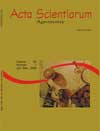<b>Carbono da biomassa microbiana e micorriza em solo sob mata nativa e agroecossistemas cafeeiros</b> - DOI: 10.4025/actasciagron.v25i1.2468
Resumo
As propriedades microbiológicas de um Latossolo Vermelho distrófico (LVd) sob cafeeiros em sistemas de produção orgânica (O), em conversão (E) e convencional (CV) foram estudadas em relação a um fragmento de mata nativa (MN), em duas fazendas contíguas localizadas em Santo Antônio do Amparo/MG/Brasil. As lavouras apresentam a mesma cultivar (Acaiá IAC-474-19) e idade (5 anos). A amostragem microbiológica do solo foi feita nos períodos seco (julho/99) e chuvoso (dezembro/99). O carbono da biomassa microbiana apresentou maiores valores na época chuvosa em todos os sistemas. Não foram registradas diferenças para a colonização micorrízica e, em relação às espécies de fungos micorrízicos arbusculares identificados, a freqüência de ocorrência foi maior para os gêneros Acaulospora, Glomus e Gigaspora, em todos os tratamentos.Downloads
DECLARAÇÃO DE ORIGINALIDADE E DIREITOS AUTORAIS
Declaro que o presente artigo é original, não tendo sido submetido à publicação em qualquer outro periódico nacional ou internacional, quer seja em parte ou em sua totalidade.
Os direitos autorais pertencem exclusivamente aos autores. Os direitos de licenciamento utilizados pelo periódico é a licença Creative Commons Attribution 4.0 (CC BY 4.0): são permitidos o compartilhamento (cópia e distribuição do material em qualqer meio ou formato) e adaptação (remix, transformação e criação de material a partir do conteúdo assim licenciado para quaisquer fins, inclusive comerciais.
Recomenda-se a leitura desse link para maiores informações sobre o tema: fornecimento de créditos e referências de forma correta, entre outros detalhes cruciais para uso adequado do material licenciado.




















































